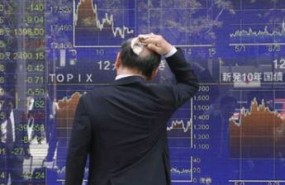- The selective turned upward after the announcement, although banks fell
- The next resistance of the index is at 10,290-10,300 points

The Ibex closed green after the decision of the European Central Bank (ECB) to complete the purchases of assets in December, the rest of the stock exchanges of the Old Continent followed. The selective closed the session with a rise of 0.6%, to 9,957 points, despite listing losses at the beginning of the session.
- 11.435,700
- -0,28%
The Ibex started the session with falls of 0.2-0.3%, but the decision of the ECB has made it turn around. The body chaired by Mario Draghi has made it official that the end of the QE will be in December. It will allocate €30,000m monthly to the purchase of debt until September and €15,000m in the last quarter.
BUSINESS
DIA was the most bullish value of the session when closing with a rise of 5.03%. At a certain distance it was followed by Técnicas Reunidas (+ 2.89%), Mediaset (+ 2.48%) and Gas Natural (+ 2.2%). The power company has renewed its alliance with the Algerian Sonatrach, which "ensures stability in the supply of gas in Spain," in the words of its president, Francisco Reynés.
On the other hand, a large part of the banking sector performed badly, especially Bankia (-2.02%), Bankinter (-1.79%), CaixaBank (-1.76%) and Sabadell (-1.71%). Also this Thursday HSBC has raised its commitment to Banco Santander (+ 0.34%) after the "political normalization" and has raised its recommendation to "buy".
Inditex (+ 0.3%), which presented the results of its first fiscal quarter and led the Ibex's earnings on Wednesday, has made the news again after Barclays raised its target price to 34 euros from the previous 32 euros . The textile company closed the session with a rise of 0.5%.
Regarding the main board, Duro Felguera closed with a rise of 2.38% after confirming the agreement with its new Arab partner, ACEC, which plans to participate in the capital increase that it expects to approve this Friday.
MACROECONOMY AND CURRENCIES
As for the euro, the community currency falls against the dollar by 1.3% to 1.1638.
At the macro level in Europe, Germany has published its inflation data or Consumer Price Index (CPI) for the fifth month of the year, as well as France. In Germany, the data has shot up to 2.2% year-on-year in May, a level not seen since February 2017.
On the other side of the Atlantic, Wall Street closed at the lows of the day after the Federal Reserve raised interest rates to 1.75% - 2% and now anticipates two more increases in the remainder of the year. Finally, the Asian stock markets finished in red on Thursday.
TECHNICAL ANALYSIS
The technical analyst of Bolsamanía, José María Rodríguez believes we started the week talking about a return to the 'island' in the Ibex 35, a type of training that usually brings significant upward movements with one condition: that the daily bullish gap (and probably weekly) is respected.
Having said all this, the analyst points out that "everything suggests that the 10,000 points will be attacked shortly". Of course, remember that this level is not any resistance, "it's just a round number, beautiful and psychological." The real resistance, according to Rodriguez, is at the highs of May, at 10,290-10,300 points, "and above this we can talk about a return figure (with bullish implications) in our index".
On the European stock exchanges, the expert remembers that for weeks the European stock exchanges (it is seen more clearly in the Dax and the Euro Stoxx 50) are in May's lows, and so far as they do not perforate said supports, it's logical to look towards the May highs and, above, the annual highs. "Another very different thing is that today the Ibex is still much weaker than its neighbors," adds Rodriguez. "The really important thing is that the supports have worked and now we are going to see if we attack, once and for all, the resistances: the May maximums," he concludes.




